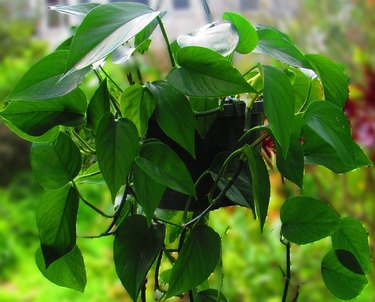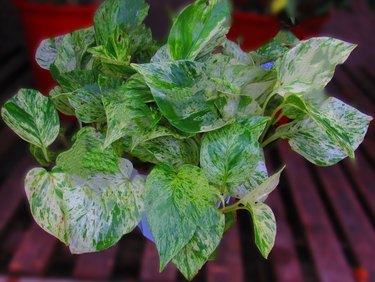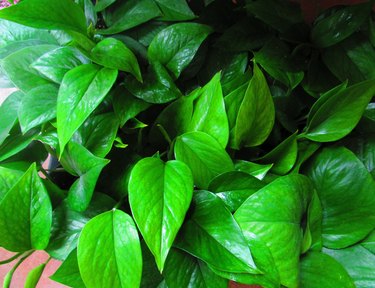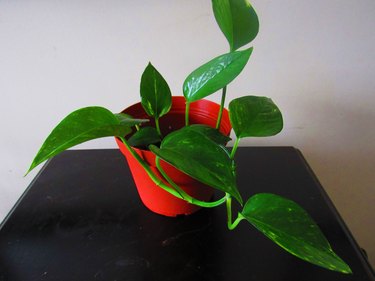
Before you invite any plant into your home, consider the care it requires. Some houseplants are high-maintenance guests, requiring you to cater to their whims, while others seem happy just to be sharing your space. The golden pothos, known botanically as Epipremnum aureum, is definitely one of the latter. In fact, it may be the ultimate beginner plant since it's utterly enchanting but almost unkillable.
Pothos are lovely vining plants with heart-shaped leaves. The lush foliage is appealing whether it drapes over the edge of a container, cascades from a hanging basket, or climbs a moss pole. But pothos plants are also as tough as nails, requiring little maintenance and tolerating most growing conditions. Though these plants are great for beginners, their appeal is universal. I personally own seven of them!
Video of the Day
Video of the Day
Epipremnum aureum Highlights
- Easy Care? Yes!
- Light and Location: Shade to bright, indirect light
- Watering: Every couple weeks if soil is dry
- Growth Rate: Fast-growing, up to 18 inches a month!
- Flowering: Very unlikely for houseplants to bloom
- Pet-Safe? No! Toxic to dogs and cats
All About Golden Pothos
It's hard not to rave about the resilience of a pothos. The plants are adaptable to almost any indoor living situation, from bright light to low light, and are equally happy climbing a pole in a container or flowing over the edge in a green waterfall of leaves. As long as the indoor temperature is above 50°F, pothos is happy. I keep one in the bathroom and learned that they adore high-humidity environments. If you love easy-care foliage plants, pothos should top your list.
What about flowers? The botanical name of the pothos, Epipremnum aureum, is Latin for "golden flowers on a tree stump," so I figured flowers were sure to come. I was wrong. The name tells you more about what these vines look like in the wild than what to expect in a dining room. Pothos are native to the tropical forests of French Polynesia, Australia, and Southeast Asia, where the vines can climb more than 50 feet and the leaves can get 30 inches wide. In this setting, the plant produces golden spade-shaped flowers with long, conical seed heads. But that won't happen in your bathroom or bedroom.

Types of Pothos Plants
The classic pothos you find in your garden store is the golden pothos. They may be the default variety, but they are truly lovely, with bright green heart-shaped leaves with a yellow variegation. Don't make the mistake I did and assume that the color is unrelated to sun exposure. In deep shade, the pothos leaves turn solid green.
If you really want to brighten a dark corner, you might want to look for an eye-catching variety like neon pothos (Epipremnum aureum 'Neon'). These are just as low-fuss as golden pothos, but the leaves are yellow-green.
A few other pothos cultivars offer deeper variegation, but they require a little more light to hold their color. The marble queen pothos (Epipremnum aureum 'Marble Queen') offers an appealing ivory variegation. N'Joy pothos (Epipremnum aureum 'N'Joy') has bolder white/cream coloring with smaller, thinner leaves. Snow Queen pothos (Epipremnum aureum 'Snow Queen') is perhaps the most highly variegated variety. Given the small amount of green on the leaves, place it in a site with bright, indirect light.

How to Care for Pothos
I used to scoff at the term "unkillable" when it comes to houseplants, but after I bought my first pothos, I changed my mind. Pothos seem to thrive on neglect, as I learned a few years back when I left town for a month. My neighbor agreed to water my houseplants but totally missed the pothos in my bathroom. But when I went to inspect it, I found that its leaves hadn't even wilted.
To set up your plant to be this tough, be sure to meet its basic needs.

Best Location for Pothos
Although pothos thrive in normal household temperatures, don't place the plant near a heater or air conditioner. Site it where it gets indirect sun for best growth. That said, some of my pothos are in very low-light positions and remain vibrant.

Potting Soil for Pothos
Pothos are said to like slightly acidic, well-draining soil, but frankly, any standard houseplant potting mix will work. The plants really don't care.
Container for Pothos
Good drainage holes are a must. Terra cotta pots or ceramic pots are ideal.

Best Temperature and Humidity for Pothos
As long as you keep your home a comfortable temperature for yourself, your pothos will also be happy. If you can do high humidity, go for it. But if you can't, don't worry. I kept a humidifier in the living room for some years but never replaced it after it broke. I see absolutely no difference in my plants.
How to Water Pothos Plants
Every plant on Earth does better with little water, and though pothos is tough, try to help it out. Water the plant generously when the soil has dried out. An easy rule: Plan to water every two weeks. Adequate water keeps the plant thick and lush.

Does Pothos Need Fertilizer?
It's hard to find a "how to" plant article that doesn't recommend fertilizer, but it's a recommendation to take with a grain of salt. Many plants, including pothos, aren't heavy feeders. I don't fertilize my pothos; they grow plenty fast without it. If you want maximum growth, apply a diluted liquid houseplant fertilizer monthly but only during spring and summer.
How to Prune Pothos
Pothos is a fast-growing vine, and sometimes the vine growth gives the plant a leggy look. Trimming will stimulate branching, which creates new foliage. Snip each leggy vine to the desired length, making every cut just below a leaf node. It's best to do this in spring or summer since the plant is growing fastest. At the same time, take out any faded or damaged foliage.

How to Propagate Pothos
If you have one healthy pothos, you can have many plants in short order by rooting cuttings. This is easy peasy with pothos. You snip off a stem, put it in water, and the cutting roots. This coordinates well with pruning. Here's how to proceed:
- Pick a stem with bright, healthy leaves.
- Take a 6-inch cutting, making the snip just below a leaf node. Remove the leaves on the bottom 3 inches.
- Put water in a clear glass or vase that is tall enough to accommodate the cutting. Place the cutting, cut end first, in the water. Be sure the leaves are above the water.
- Change the water every week. After a few weeks, you should see white dots on the cutting stem. These will turn into roots. When they are several inches long, transplant the cutting into a pot of well-draining soil.
